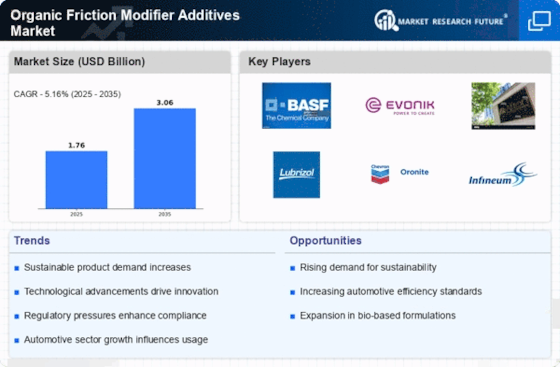Consumer Awareness and Education
The rising consumer awareness regarding the benefits of organic products is a notable driver in the Organic Friction Modifier Additives Market. As consumers become more educated about the environmental and health impacts of chemical additives, there is a growing preference for organic alternatives. This shift is prompting manufacturers to highlight the advantages of their organic friction modifiers, such as improved biodegradability and lower toxicity. Educational campaigns and marketing strategies aimed at informing consumers about the benefits of organic additives are becoming increasingly prevalent. This heightened awareness is expected to contribute to a steady increase in market demand, with estimates suggesting a potential growth of 5% in the market as consumers actively seek out safer and more sustainable options.
Stringent Environmental Regulations
The imposition of stringent environmental regulations is a critical driver for the Organic Friction Modifier Additives Market. Governments across various regions are implementing policies aimed at reducing emissions and promoting the use of environmentally friendly products. These regulations compel manufacturers to seek alternatives to traditional friction modifiers, which often contain harmful substances. Consequently, there is a marked shift towards organic additives that comply with these regulations, thereby fostering market growth. The regulatory landscape is expected to become increasingly rigorous, with more countries adopting similar measures. This trend not only drives demand for organic friction modifiers but also encourages innovation in the development of compliant products, further enhancing the market's potential.
Rising Demand for Eco-Friendly Products
The increasing consumer preference for eco-friendly products is a pivotal driver in the Organic Friction Modifier Additives Market. As industries strive to reduce their environmental footprint, the demand for organic additives that enhance performance while being less harmful to the environment is on the rise. This trend is particularly evident in sectors such as automotive and industrial lubricants, where the shift towards sustainable practices is becoming more pronounced. Market data indicates that the organic friction modifier additives segment is expected to witness a compound annual growth rate of approximately 5% over the next few years, reflecting the growing inclination towards sustainable solutions. Companies are increasingly investing in research and development to create innovative organic additives that meet these evolving consumer demands, thereby propelling the market forward.
Growth in Automotive and Industrial Sectors
The expansion of the automotive and industrial sectors is a significant driver for the Organic Friction Modifier Additives Market. As these sectors continue to grow, the demand for high-performance lubricants that incorporate organic friction modifiers is increasing. The automotive industry, in particular, is focusing on enhancing fuel efficiency and reducing emissions, which aligns with the benefits offered by organic additives. Market analysis suggests that the automotive sector alone accounts for a substantial share of the overall market, with projections indicating a growth rate of around 6% in the coming years. This growth is likely to be fueled by the ongoing transition towards electric vehicles and the need for advanced lubrication solutions that meet stringent performance standards.
Technological Innovations in Additive Formulation
Technological advancements in the formulation of organic friction modifier additives are significantly influencing the Organic Friction Modifier Additives Market. Innovations in chemical engineering and material science have led to the development of more efficient and effective additives that enhance lubrication properties while minimizing wear and tear. These advancements not only improve the performance of lubricants but also contribute to longer equipment life and reduced maintenance costs. The market is witnessing a surge in the introduction of new formulations that utilize bio-based materials, which are gaining traction due to their superior performance characteristics. As a result, the market is projected to grow steadily, with estimates suggesting an increase in market size by 4% annually as manufacturers adopt these cutting-edge technologies.

















Leave a Comment